By Peter M. DeLorenzo
Elkhart Lake. It's quiet up here in the winter, but the stark beauty of the Kettle Moraine country remains vibrant through the cold. And the unmistakable sound of throbbing V8s echoing around Road America is just a daydream away. It was somehow fitting that this beautiful, 4.048-mile, fourteen turn circuit carved out on an almost 600-acre parcel of Wisconsin farm land just south of the village of Elkhart Lake became the epicenter of road racing in North America.
The vision that became Road America belonged to Clif Tufte, a highway engineer who organized a group of friends from the Chicago Region of the Sports Car Club of America to invest in the project, after racing on public roads in and around Elkhart Lake was banned by the state legislature. Tufte famously walked the property marked by the dramatic hills and plunging ravines of the glacially-formed Kettle Moraine topography, and personally laid out the circuit that remains, remarkably, intact and unchanged to this day. I don't know if his vision imagined what Road America would become, because it is now considered to be one of the most famous and challenging road racing circuits in the world, and the finest facility in the U.S. Dubbed "America's National Park of Speed" by yours truly, Road America remains a national treasure for enthusiasts of all stripes.
Tufte's vision became a reality on September 10, 1955, when the first race - an SCCA National race weekend - took place. And from then on, traveling to Elkhart Lake became an annual pilgrimage for racers that thrives to this day. Ironically enough, Road America wasn't on the Can-Am calendar in 1966, the first year that the unlimited series was run, but that was rectified for the 1967 season, and from then on, Road America became the spiritual home of the iconic and historically important racing series. Part of this had to do with the fact that the primary sponsor that made the Can-Am Series the richest road racing series in the world - yes, even more than F1 - was Johnson Wax, which was headquartered in Racine, Wisconsin, just 80 minutes from Elkhart Lake.
For those of you who had the privilege of seeing the original Can-Am Series in-period, as I did, it's something that's permanently seared in our memories. Each year, at the vintage weekend at Road America, a fine representation of Can-Am machines from the era are present, and you can get a taste of what it was really like back in the day. Well, close, anyway; back then there was no catch fencing around the track, and when those Can-Am machines powered down the Moraine Sweep headed to Turn 5 at 185mph+, with the sun glinting off of their wings and the gut-wrenching roar of those V8s penetrating your soul, you felt like they were close enough to reach out and touch. Simply unforgettable.
We are presenting a selection of famous photographs (below) taken of the Can-Am Series at Road America. As I've said many times before, it was a different time and a different era, and definitely worth another look.
And that's the High-Octane Truth for this week.
![]()
(Photo by Pete Lyons)
Elkhart Lake, Wisconsin, September 3, 1967. The start of the Can-Am at Road America with Stirling Moss at the wheel of the specially-modified Chevrolet Camaro pace car: Bruce McLaren (No. 4 McLaren M6A Chevrolet); Denny Hulme (No. 5 McLaren M6A Chevrolet); Dan Gurney (No. 36 All American Racers Lola T70 Mk.3B Weslake-Ford); George Follmer (No. 16 Roger Penske Racing Ent. Sunoco Lola T70 Mk.2 Chevrolet); Mark Donohue (No. 6 Roger Penske Racing Ent. Sunoco Lola T70 Mk.3B Chevrolet); Chuck Parsons (No. 26 McLaren Elva Mark III Chevrolet); John Surtees (No. 7 Team Surtees Limited Lola T70 Mk.3B Chevrolet); Peter Revson (No. 52 Peyton Cramer/Dana Chevrolet Lola T70 Mk.3 Chevrolet) and Jim Hall (No. 66 Chaparral Cars Chaparral 2G Chevrolet).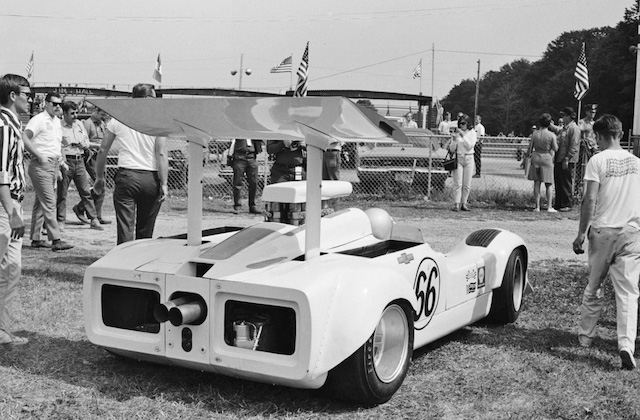 Elkhart Lake, Wisconsin, September 1968. Jim Hall (No. 66 Chaparral 2G Chevrolet) heading out for Can-Am practice at Road America.
Elkhart Lake, Wisconsin, September 1968. Jim Hall (No. 66 Chaparral 2G Chevrolet) heading out for Can-Am practice at Road America.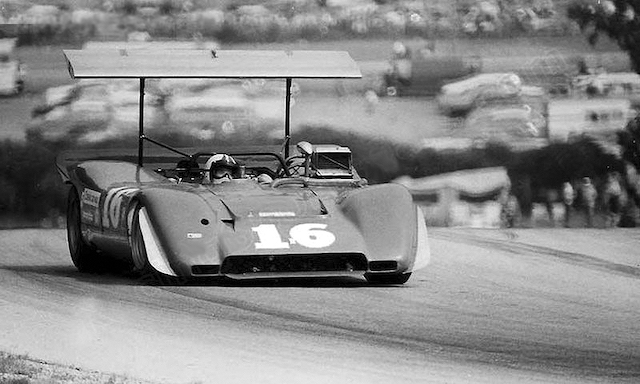 Elkhart Lake, Wisconsin, August 31, 1969. Chris Amon (No. 16 Ferrari 612 P) crests the hill at Turn 6 at Road America.
Elkhart Lake, Wisconsin, August 31, 1969. Chris Amon (No. 16 Ferrari 612 P) crests the hill at Turn 6 at Road America.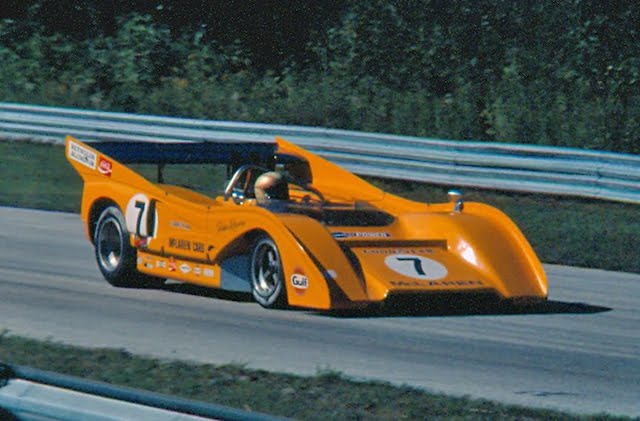 Peter Revson (No. 7 McLaren M8F Chevrolet) on the way to the win in the Can-Am at Road America, 1971.
Peter Revson (No. 7 McLaren M8F Chevrolet) on the way to the win in the Can-Am at Road America, 1971.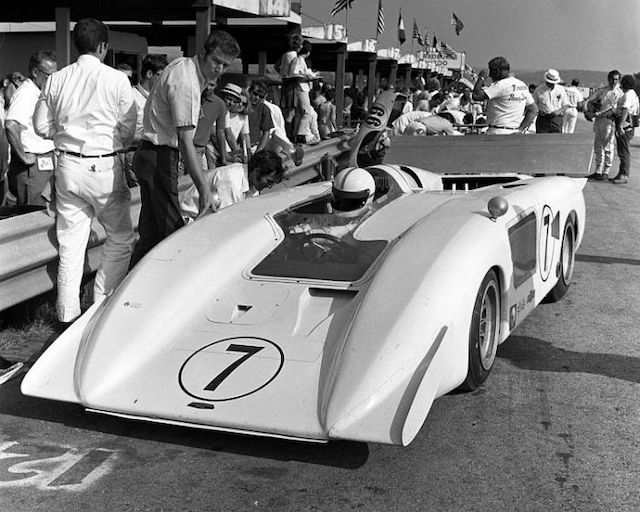 Jim Hall leans on the radical No. 7 Chaparral 2H Chevrolet as John Surtees prepares to go out for qualifying at Road America. It was Hall's least successful Can-Am machine, August 1969.
Jim Hall leans on the radical No. 7 Chaparral 2H Chevrolet as John Surtees prepares to go out for qualifying at Road America. It was Hall's least successful Can-Am machine, August 1969. (Alvis Uptis/Getty Images)
(Alvis Uptis/Getty Images)
Jim Hall's No. 66 Chaparral 2G Chevrolet in the pits at Road America, September 1968.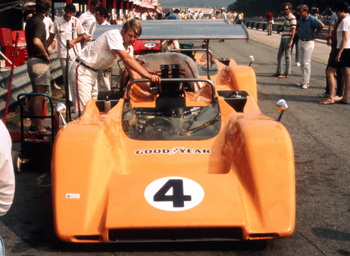 Chief Mechanic Tyler Alexander leans on Bruce McLaren's No. 4 McLaren M8B Chevrolet during practice for the Road America Can-Am, 1969.
Chief Mechanic Tyler Alexander leans on Bruce McLaren's No. 4 McLaren M8B Chevrolet during practice for the Road America Can-Am, 1969.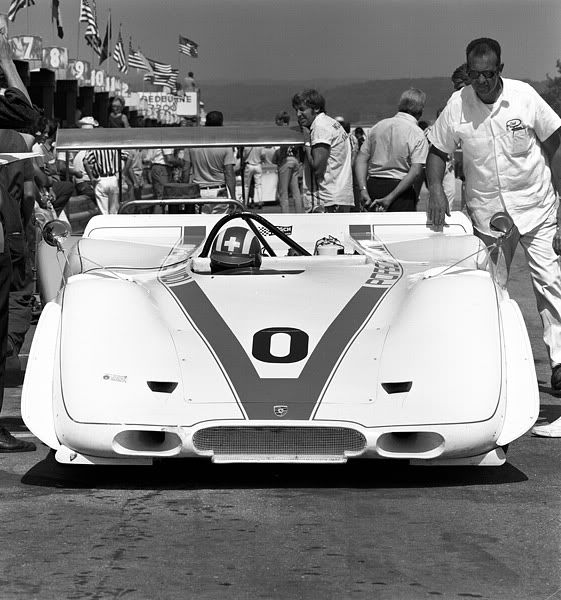 Jo Siffert (No. 0 Porsche 917 PA) during practice for the Road America Can-Am, August 1969.
Jo Siffert (No. 0 Porsche 917 PA) during practice for the Road America Can-Am, August 1969.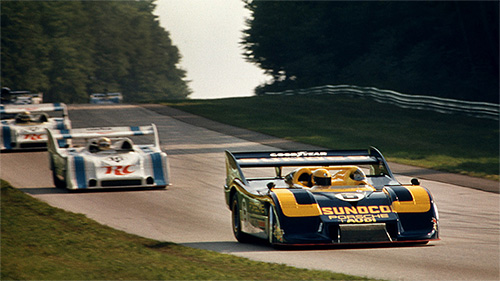 Mark Donohue in the all-conquering No. 6 Penske Racing Sunoco/Porsche+Audi Porsche 917/30 Turbo on his way to the win in the Can-Am at Road America, August 26, 1973.
Mark Donohue in the all-conquering No. 6 Penske Racing Sunoco/Porsche+Audi Porsche 917/30 Turbo on his way to the win in the Can-Am at Road America, August 26, 1973.
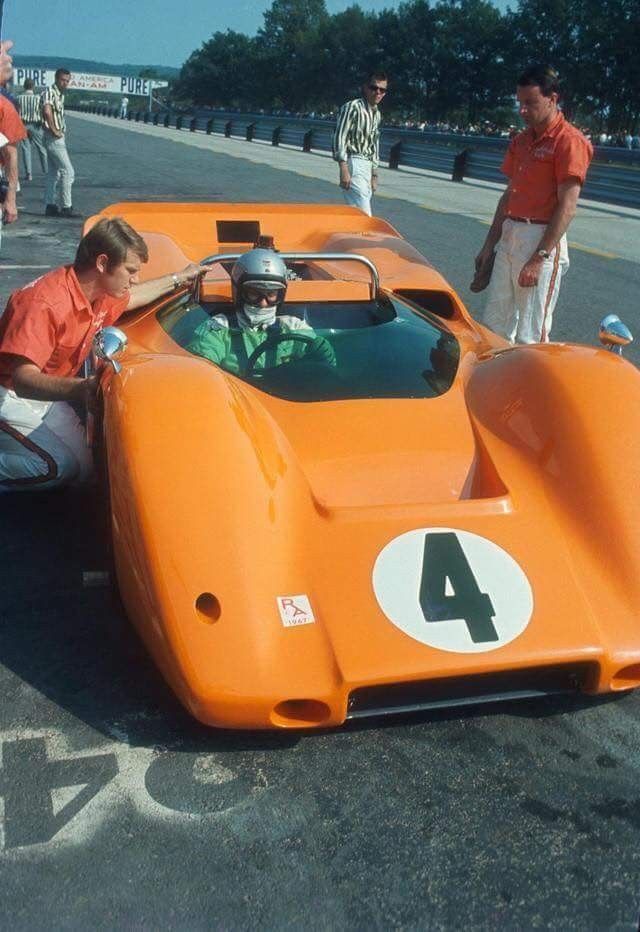 Bruce McLaren (No. 4 McLaren McA Chevrolet) with Tyler Alexander during practice for the Road America Can-Am, September 1967.
Bruce McLaren (No. 4 McLaren McA Chevrolet) with Tyler Alexander during practice for the Road America Can-Am, September 1967.
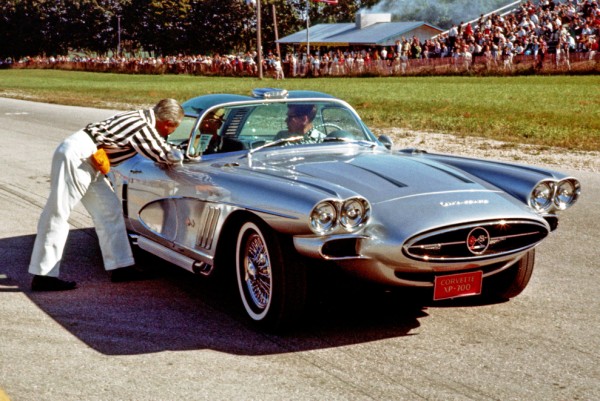
(Photo by Tom Schultz)
Clif Tufte in the passenger seat of the Chevrolet Corvette XP-700 concept at Road America, September, 1960. Bill Mitchell, the legendary GM Styling Chief, often sent the latest GM concepts up to Road America to get enthusiasts' reaction.